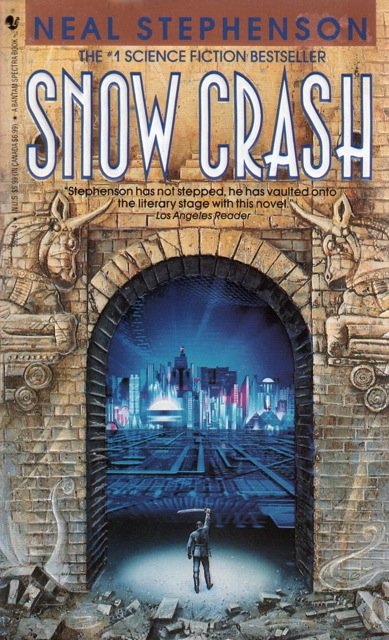The Significance of “Snow Crash”, 30 years later
This month marks the 30th anniversary of Neal Stephenson’s future-forward novel, Snow Crash, which dreamed up the concept of the Metaverse — and first coined the term — well ahead of its time. While many of the ideas seemed fantastical and far-reaching when first published in June of 1992, we’ve seen the science fiction hit become increasingly realistic with each passing year. Fast forward to today and the term “Metaverse” feels ubiquitous. With top tech companies racing to build this future world, what parallels can be made with Snow Crash, what lessons can we learn?
Snow Crash coins the term Metaverse
Stephenson describes the Metaverse (a term he coined) as a virtual world composed of unique environments, each with a specific purpose: to entertain, socialize, educate, and more. In the case of Snow Crash, it’s largely used to transport users out of the bleak physical reality of a dystopian, post-global economic collapse West Coast. Using head-mounted displays (HMDs), smartphones, and other media technology, people enter these shared spaces and engage with one another regardless of their location.
"When you live in a s***hole, there's always the Metaverse, and in the Metaverse, Hiro Protagonist is a warrior prince." - Hiro Protagonist, Snow Crash
The book chronicles the adventures of cleverly named main character Hiro Protagonist, a hacker and pizza delivery driver for the Mafia. He, like many others in the novel, enjoys the Metaverse as a form of escapism, but it’s not all fun and games — Hiro finds himself at the center of a battle to neutralize the titular computer virus, Snow Crash, which causes real-life brain damage to Metaverse users.
While that plot point, as well as an all-out dystopia, has not (and hopefully will not) come to fruition in the real world, a striking amount of what Stephenson describes reads like non-fiction in 2022.
Snow Crash parallels to current reality
With each passing day, the lines continue to blur between the pages of Snow Crash and our reality. For example, users gain entry to the Metaverse through the use of VR (virtual reality) headsets much like Meta’s Oculus Quest and Quest 2, while customizable avatars like we see in any popular MMO (massively multiplayer online game) allow for personal expression.
Headmounted displays (HMDs) like virtual reality headsets
Customizable avatars
Large-scale virtual events like concerts
Economic disparity in the virtual world, too
Electronic currency
During the pandemic, we also began to see the rise in popularity of virtual concerts via platforms like Minecraft and Fortnite, which (although not as sinister) is not unlike a scene from the book where the threat of a Snow Crash spread looms at a Metaverse concert.
Snow Crash also describes vast economic disparity even within the Metaverse, which we’re already seeing manifest in our world by way of NFTs, a booming virtual real estate market, designer avatar skins, and more, and the novel’s electronic currency is analogous to the cryptocurrencies gaining popularity today.
As you can see, there’s plenty of overlap. (If that’s piqued your interest, you can read even more about why Stephenson’s been dubbed a techno-prophet in this Digiday interview.) Is this just the tip of the iceberg?
Can we give the Metaverse a happy ending?
It’s truly fascinating to think that Snow Crash was so ahead of its time, and we congratulate Stephenson on this momentous 30-year milestone. We’d highly recommend checking it out for a fun read, but we hope you’ll join us in adopting an optimistic outlook toward what the Metaverse has to offer.
That said, there are definite pitfalls we need to avoid if we want the Metaverse to feel more like a fairytale and less like a horror story. As we mentioned, some of the inequities Stephenson describes in Snow Crash are already beginning to bleed into the digital realm. We need to design the Metaverse with everyone in mind, regardless of background. This includes making technologies maximally accessible, ensuring inclusive immersive experiences, and everything in between.
If we put in the work together to avoid harmful practices, we have full confidence that the Metaverse can afford a deeper sense of empathy and belonging. Read more about the possibilities in our free PDF guide to the Metaverse.



